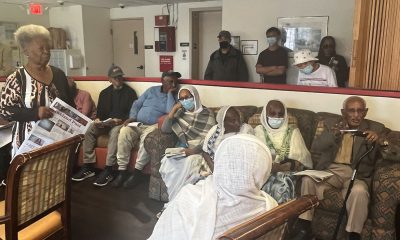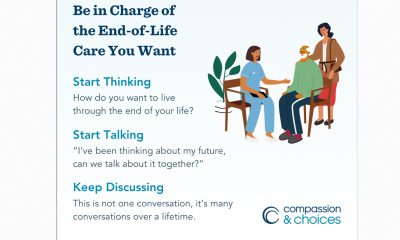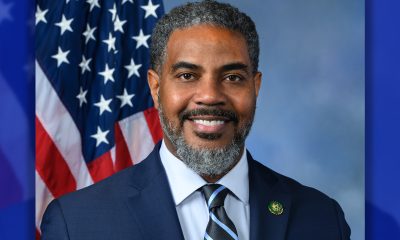Health
High Nursing Home Bills Squeeze Insurers, Driving Rates Up

In this Feb. 28, 2013, file photo, Tina Reese leads a word game for residents at a nursing home in Lancaster, Pa. Life insurance firms pitched long-term care policies as the prudent way for Americans to shoulder the cost of staying in nursing homes. But those same companies have found that long-term-care policies are squeezing their profits. (AP Photo/Intelligencer Journal, Dan Marschka)
MATTHEW CRAFT, AP Business Writer
NEW YORK (AP) — Thirty years ago, insurance companies had the answer to the soaring cost of caring for the elderly. Plan ahead and buy a policy that will cover your expenses.
Now, there’s a new problem: Even insurers think it’s unaffordable.
Life insurance firms pitched long-term care policies as the prudent way for Americans to shoulder the cost of staying in nursing homes. But those same companies have found that long-term-care policies are squeezing their profits. Earnings for life insurers slid 11 percent in the most recent quarter, according to Moody’s Investors Service, and long-term care was the chief culprit.
“Insurers that sell these products lose money on them,” says Vincent Lui, a life-insurance analyst at Morningstar. “So they’re raising prices and also trying to get out of the business right and left.”
Four of the five largest providers — including Manulife and MetLife — have either scaled back their business or stopped selling new policies, according to Moody’s. The largest provider, Genworth Financial, continues to offer them, yet has struggled under the weight of rising costs.
The trends behind the industry’s troubles sound like good news outside the world of insurance. Older Americans are healthier and living longer. But that makes it difficult for the industry to turn a profit. Stays in nursing homes tend to last longer, so insurers have to pay out more in benefits than they had planned.
For older Americans and their families, however, there are few options besides private insurance. Medicare doesn’t cover nursing home stays except in certain circumstances. The Obama Administration had planned to make a long-term insurance program part of the Affordable Care Act but eventually abandoned it.
Sean Dargan, an analyst at Macquarie Group, an Australia-based investment bank, expects to see more people turning to Medicaid, the government’s health insurance for the poor, to cover the costs of care.
“It could really blow a hole through state budgets,” he says. “I think states and the federal government are going to need to think creatively to find a way out of this.”
For insurance companies, long-term care has proven to be a tough business.
Genworth, based in Richmond, Virginia, has turned in losses for two straight quarters. On March 2, the company reported that it discovered errors in its accounting for funds set aside to cover long-term care claims, knocking its stock down 5 percent in a single day. Analysts say problems with these policies explain why Genworth has lost more than half its market value over the past year, plunging from $17 to a recent $7.79.
“Their single biggest product is long-term care, and look at their share price,” Lui says. “It’s one trouble after another.”
In an interview with The Associated Press, Tom McInerney, Genworth’s CEO, says his company has been taking steps to make long-term care insurance a viable business, raising prices on older policies, introducing new products and throwing out their previous assumptions.
“There’s clearly a very high need for these policies,” McInerney says. “Given high demand and the limited number of insurers offering it today, I think it can be a very good industry going forward.”
When they began selling policies widely in the 1980s, the industry made a slew of assumptions about how long people would live, health care costs, and interest rates. Nearly all of them turned out wrong, analysts say.
Take life spans. At nearly 79 years, overall life expectancy in the U.S. has never been higher, according to the Centers for Disease Control and Prevention. That’s the biggest issue, analysts say, because it means more people who took out policies stick around to make claims, moving into nursing homes and asking insurance companies to help cover the steep bills.
The rate for staying at a nursing home has gone up an average of four percent every year for the last five years, according to Genworth’s annual survey. In 2014, the median bill for a shared room topped $6,000 a month.
“They were making their best estimates at the time. They just turned out to be wrong,” says Shachar Gonen, a Moody’s analyst who covers the industry. “If insurers knew full well what they were getting into, they probably would have priced their policies much higher. So who knows if the long-term insurance business would have ever started.”
The industry’s actuaries also made a bad call on the bond market, betting on much higher interest rates. That misstep proved critical because insurers buy bonds to cushion against future payouts, so years of historically low interest rates have thrown their accounts out of balance. It’s yet another reason why insurers keep putting more money aside to cover claims, resulting in big charges and lower profits.
All of these trends have forced companies like Genworth to spend much more than they had planned. Last year, insurers paid out a record $7.5 billion in claims on these policies, according to the American Association of Long-Term Care Insurance, which tracks insurance rates.
To cope with mounting costs and faulty assumptions, insurers have been cutting benefits and hiking their premiums year after year. Average premiums for new policies rose nearly 9 percent over the past year.
Prices range widely, depending on where you live, your age, level of benefits, and much else. In Tennessee, for instance, a 55-year old woman who is healthy enough to qualify for a policy can expect to pay $2,411 in the first year for $136,000 in benefits. That’s a brand-new policy, likely the lowest premium a person will pay. The expense climbs steadily as people age, and those holding policies typically don’t make a claim until they reach their 80s.
Insurers keep asking state regulators to let them raise prices on existing policies. In the last month, TIAA-CREF Life Insurance, MetLife and American General asked Connecticut’s insurance department for permission to raise rates as much as 22 percent over three years. The state rejected American General’s request and approved the other two.
McInerney, Genworth’s CEO, says that when regulators refuse to allow changes — such as signing off on single-digit rate increases or allowing other tweaks to older policies — the business becomes “‘impossible to run.”
If they’re not flexible enough to help make long-term care insurance viable for insurers, McInerney says he has told regulators that “Genworth isn’t going to stay.”
“Without it,” he adds, “a lot of these Baby Boomers are going to wind up on Medicaid.”
Analysts who follow the industry think that insurers have learned from their missteps and probably figured out the right price to charge for long-term care policies to turn a profit. The problem is, it might be too high for most people to pay.
“I’m of the opinion that it’s appropriately priced today,” says Macquarie Group’s Dargan. “But it’s also out of reach for most middle-income Americans. And that’s who needs it the most.”
Copyright 2015 The Associated Press. All rights reserved. This material may not be published, broadcast, rewritten or redistributed.
Bay Area
Mind, Body, and Spiritual Well-Being for Women Addressed in NAACP Forum in Oakland
The Women In The NAACP Oakland Branch is proud to announce the upcoming “Total You – Mind, Body, and Spirit Women’s Health Forum” scheduled for April 27 at Acts Full Gospel Church. Running from 9 a.m.-2 p.m. at 1034 66th Ave., this forum aims to provide an empowering platform for women to engage in discussions, gain knowledge, and access resources pertaining to their health and well-being.

Special to The Post
The Women In The NAACP Oakland Branch is proud to announce the upcoming “Total You – Mind, Body, and Spirit Women’s Health Forum” scheduled for April 27 at Acts Full Gospel Church.
Running from 9 a.m.-2 p.m. at 1034 66th Ave., this forum aims to provide an empowering platform for women to engage in discussions, gain knowledge, and access resources pertaining to their health and well-being.
The forum will feature renowned experts, healthcare professionals, and advocates from Genentech, John Muir Health, Sutter Health of The East Bay, Kaiser Permanente, and the Alameda County Public Health Department.
Our expert panel will address various aspects of women’s health, including physical, mental, and emotional well-being, and healthy relationships. The forum will encompass a wide range of topics such as breast cancer, menopause, reproductive health, nutrition, mental health awareness, preventive care, and much more.
Participants will have the opportunity to attend informative sessions, interactive workshops, and panel discussions led by experts in their respective fields. Additionally, there will be wellness activities, screenings, and informational booths offering valuable resources and support.
This forum is open to women of all ages and backgrounds, encouraging inclusivity and diversity in the conversation surrounding women’s health. Whether you’re seeking information for yourself, a loved one, or simply looking to connect with other women, this event promises to be enlightening and empowering.
For more information and to register for the Total You Women’s Health Forum, please visit https://www.naacpoakland.org/ or contact Dr. Delores Thompson. WIN chairwoman at (510) 328-3638.
The Women In The NAACP Oakland Branch is dedicated to empowering women, and young teen girls. We look forward to your participation in this important event.
To register, go to https://www.naacpoakland.org/events/the-total-you-womens-health-forum
Alameda County
Oakland Conducts Its Biennial ‘Point in Time’ Homelessness Count
Oakland, along with other cities in Alameda County, conducted their biennial ‘Point In Time’ census count on Feb. 1 to gain a thorough understanding of the size and dispersion of the homeless population in the region. The Point In Time (PIT) count is federally required by the Housing and Urban Development Department as a requirement to receive funding and resources to tackle homelessness in the area.

By Magaly Muñoz
Oakland, along with other cities in Alameda County, conducted their biennial ‘Point In Time’ census count on Feb. 1 to gain a thorough understanding of the size and dispersion of the homeless population in the region.
The Point In Time (PIT) count is federally required by the Housing and Urban Development Department as a requirement to receive funding and resources to tackle homelessness in the area.
David Modersbach, Grants Manager of Alameda County Health Care for the Homeless program, said that the methodology this time around was different, as this count had a much more personal “lived experience” aspect that previous counts did not have.
In 2022, the county relied more on statistical extrapolation and assumptions, but this year’s survey questionnaires allowed for details on substance abuse issues, how long someone has been living without proper housing, what resources people are in need of and much more.
“[The PIT count is] a critical opportunity for the county, Continuum of Care, and cities to understand the magnitude of homelessness in Alameda County. [The count] enables us to better allocate resources and implement effective programs to tackle this issue head-on in a compassionate and inclusive way,” Modersbach said.
St. Mary’s Center was one of the many meeting hubs across the county that hosted volunteers and community officials the morning of the count. The organization has been deeply involved in the effort to provide resources for unhoused people and others in need.
St. Mary’s is a nonprofit in West Oakland that helps seniors and preschool families with food and housing. Last year, the organization helped about 50 seniors find housing after they had fallen on hard times.
Sharon Cornu, executive director of St. Mary’s, said a lot of the older couples and individuals that come into the center have borne the brunt of the skyrocketing cost of living in the Bay Area. The most recent influx of seniors St. Mary’s has seen coming in for help has been made up of people who were evicted when the COVID-19-related moratorium on rent payment ended.
“Seniors are the fastest growing segment of the unhoused and the incredibly high cost of housing is driving them to the streets,” Cornu said.
Among the volunteers were workers with Operation Dignity, a nonprofit organization that helps veterans and those living on the street find shelter, transitional housing and supportive services.
“These are our stomping grounds,” Ivan Magana, program manager for Operation Dignity said.
Magana stated that his team was extremely familiar with the people residing in the encampments they were conducting the count in since Operation Dignity made many visits to these areas while doing community outreach. He said they had even informed some of the unhoused people they knew about the count a few days prior so they would not be alarmed when the enumerators showed up early in the morning to conduct the count.
Not everyone got the memo though, as the volunteers encountered an almost violent situation around the 6 a.m. when a young woman living in a bus yelled at the Operation Dignity workers to leave her alone.
Luckily, the three-year experience Mangana has working with Operation Dignity and his knowledge of therapeutic health services, equipped him with the techniques needed to deescalate the tension. The woman soon realized who the volunteers were and apologized, he said.
Another volunteer and Operation Dignity worker, Yolanda Kirkpatrick, noted that she was initially hesitant because of the early schedule. She felt the time deterred others from participating, too.
Her prediction would come true as the hours went on and they continued to walk along 24th St in downtown Oakland and there was very little activity on the streets.
The volunteers shared similar sentiments. Although the community the people they were engaging for the count and surveys encounter tend to distrust outsiders, the PIT count was necessary for the city to receive the appropriate level of federal funds to address a crisis that is spiraling out of control in California.
A full analysis and report of the count will be made available in the summer.
Community
For Cervical Cancer Month, Medical Community Focused on Education
January was Cervical Cancer Awareness Month. Physicians, advocates and others in the medical community commemorated the month by raising awareness about a form of cancer they say is highly preventable and treatable. Cervical cancer is caused by a virus called the human papillomavirus (HPV) and it develops slowly over time but can be prevented with proper care in girls as young as 13 years old.

By Magaly Muñoz
January was Cervical Cancer Awareness Month.
Physicians, advocates and others in the medical community commemorated the month by raising awareness about a form of cancer they say is highly preventable and treatable.
Cervical cancer is caused by a virus called the human papillomavirus (HPV) and it develops slowly over time but can be prevented with proper care in girls as young as 13 years old.
Sonia Ordonez, an OBGYN and gynecology surgeon at Kaiser Permanente, stated that as soon as people with cervixes reach the maturity reproductive age, they should start taking preventative measures like getting the HPV vaccine. The vaccine involves a series of two-doses for people aged 9 through 14 or three-doses for people 15 through 45 years old.
“I see a lot of young women who can’t remember or may not have gotten [the vaccine] when they were younger, or maybe got one, but we can give them the series of vaccines and restart at any point in time,” Ordonez said.
She said that cervical cancer is not the only cancer caused by HPV. Strains of the virus can also lead to throat, anal and penile cancers.
Screening is also an effective way to check for cervical cancer and should be done every three years after someone turns 21, doctors recommend. It is best to start as early as possible to catch occurrences early.
Ordonez said that this cancer is also more likely found in people of color and has led to more deaths overall.
A Mayo Clinic article published last month stated that Black women are more likely to be diagnosed and die of cervical cancer, compared to White women in the U.S.
2,000 Black women are diagnosed every year with cervical cancer and 40% die as a result.
“This disparity is not due to genetic differences among White, Black or Hispanic women, but rather related to systemic racism, access to healthcare and socioeconomic factors,” Dr. Olivia Cardenas-Trowers, a Mayo Clinic urogynecologist, said in the article.
Ordonez stated that immigrant women are also highly susceptible to the cancer, as many Latin American countries may not have accessibility to screenings or lack of insurance makes it harder for them to get tested.
Hispanic women are 40% more likely to be diagnosed with cervical cancer, and 30% more likely to die from it, as compared to non-Hispanic White women, according to the Office of Minority Health.
Family medicine physician, Joy Anyanwu, stated that the pandemic contributed to hesitancy about getting cervical cancer screenings among some women. Other factors are people’s aversion to vaccines, parents not wanting to believe that their children are or will become sexually active, and doubt about the overall effectiveness of the vaccine.
“The vaccine is very safe — over 97% effective in preventing cervical cancer,” Anyanwu said. “Even if you aren’t having sex, the earlier you start would actually help.”
Anyanwu said she understands that parents might not want to ask questions about their children’s reproductive health, but it’s a mindset that can be a barrier to having important conversation about prevention or care.
To keep families their families and communties healthy, the doctor emphasized that people should prioritize keeping up with their vaccine series and going to screenings every year.
-

 Activism4 weeks ago
Activism4 weeks agoOakland Post: Week of March 27 – April 2, 2024
-

 #NNPA BlackPress4 weeks ago
#NNPA BlackPress4 weeks agoBeloved Actor and Activist Louis Cameron Gossett Jr. Dies at 87
-

 Community1 week ago
Community1 week agoFinancial Assistance Bill for Descendants of Enslaved Persons to Help Them Purchase, Own, or Maintain a Home
-

 Activism3 weeks ago
Activism3 weeks agoOakland Post: Week of April 3 – 6, 2024
-

 Business1 week ago
Business1 week agoV.P. Kamala Harris: Americans With Criminal Records Will Soon Be Eligible for SBA Loans
-

 Activism2 weeks ago
Activism2 weeks agoOakland Post: Week of April 10 – 16, 2024
-

 Community1 week ago
Community1 week agoAG Bonta Says Oakland School Leaders Should Comply with State Laws to Avoid ‘Disparate Harm’ When Closing or Merging Schools
-

 Community6 days ago
Community6 days agoOakland WNBA Player to be Inducted Into Hall of Fame


























































